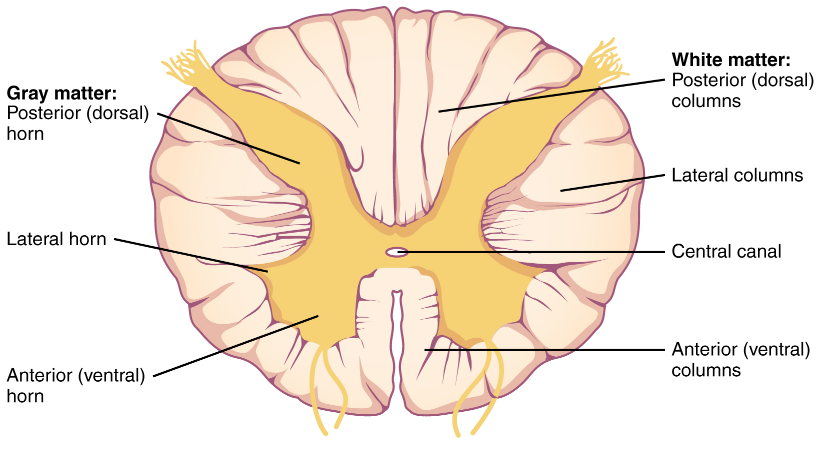
Answer
421.2k+ views
Hint: Spinal nerves are a part of the peripheral nervous system. They transmit motor, sensory and autonomic signals between the central nervous system and the body. All spinal nerves are made up of both sensory and motor fibres, that is they are mixed nerves.
Complete answer:
There are about 31 pairs of spinal nerves present. They control the motor and sensory signalling, along with other functions. These nerves are present at the cervical, thoracic, lumbar, and coccygeal levels. Out of 31 pairs of spinal nerves, 8 are cervical, 12 are thoracic, 5 are lumbar, 5 are sacral and 1 is coccygeal. Each pair of nerves connects the spinal cord with a specific region of the body. Spinal nerve present near the spinal cord branches into two roots. One branch is sensory fibres and the other is motor fibres. Each spinal cord segment has four roots- an anterior root and a posterior root that are present on the right and left side. Each of these roots further has the presence of 8 nerve rootlets. The anterior root contains efferent nerve fibres whose function is to carry the stimuli away from the central nervous system towards the target. The cell bodies of the ventral roots are present in the central grey matter of the spinal cord. Motor neurons that control skeletal muscles and preganglionic autonomic nerves are located in the ventral root.
The posterior root contains afferent nerve fibres whose function is to return the sensory information from the central nervous system’s trunk and limbs. The cell bodies are not present in the grey matter but are present in the dorsal root ganglion. The posterior and the anterior nerves join together and form nerve proper. The nerve proper is made up of a mixture of sensory, motor and autonomic fibres.

Note: The spinal cord is a long and fragile tubelike structure that extends from the brain to the bottom of the spine. The spinal cord is made up of nerve fibres that carry signals away from the brain to different parts of the body. If the spinal cord gets damaged, then the muscle will completely lose its function and there will be no sensation of the body.
Complete answer:
There are about 31 pairs of spinal nerves present. They control the motor and sensory signalling, along with other functions. These nerves are present at the cervical, thoracic, lumbar, and coccygeal levels. Out of 31 pairs of spinal nerves, 8 are cervical, 12 are thoracic, 5 are lumbar, 5 are sacral and 1 is coccygeal. Each pair of nerves connects the spinal cord with a specific region of the body. Spinal nerve present near the spinal cord branches into two roots. One branch is sensory fibres and the other is motor fibres. Each spinal cord segment has four roots- an anterior root and a posterior root that are present on the right and left side. Each of these roots further has the presence of 8 nerve rootlets. The anterior root contains efferent nerve fibres whose function is to carry the stimuli away from the central nervous system towards the target. The cell bodies of the ventral roots are present in the central grey matter of the spinal cord. Motor neurons that control skeletal muscles and preganglionic autonomic nerves are located in the ventral root.
The posterior root contains afferent nerve fibres whose function is to return the sensory information from the central nervous system’s trunk and limbs. The cell bodies are not present in the grey matter but are present in the dorsal root ganglion. The posterior and the anterior nerves join together and form nerve proper. The nerve proper is made up of a mixture of sensory, motor and autonomic fibres.

Note: The spinal cord is a long and fragile tubelike structure that extends from the brain to the bottom of the spine. The spinal cord is made up of nerve fibres that carry signals away from the brain to different parts of the body. If the spinal cord gets damaged, then the muscle will completely lose its function and there will be no sensation of the body.
Recently Updated Pages
How many sigma and pi bonds are present in HCequiv class 11 chemistry CBSE

Mark and label the given geoinformation on the outline class 11 social science CBSE

When people say No pun intended what does that mea class 8 english CBSE

Name the states which share their boundary with Indias class 9 social science CBSE

Give an account of the Northern Plains of India class 9 social science CBSE

Change the following sentences into negative and interrogative class 10 english CBSE

Trending doubts
Fill the blanks with the suitable prepositions 1 The class 9 english CBSE

Which are the Top 10 Largest Countries of the World?

The Equation xxx + 2 is Satisfied when x is Equal to Class 10 Maths

How do you graph the function fx 4x class 9 maths CBSE

Difference between Prokaryotic cell and Eukaryotic class 11 biology CBSE

Difference Between Plant Cell and Animal Cell

Give 10 examples for herbs , shrubs , climbers , creepers

Write a stanza wise summary of money madness class 11 english CBSE

Change the following sentences into negative and interrogative class 10 english CBSE



